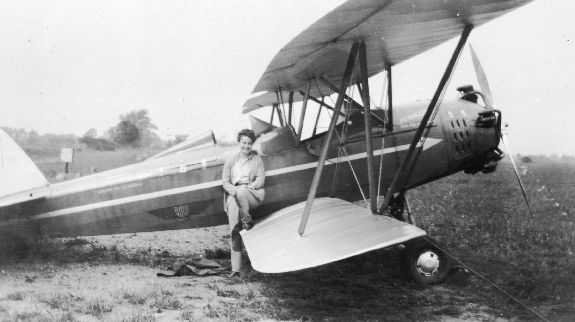Remembering the Amelia Earhart of Pittsburgh
Record-setting aviation pioneer Helen Richey was first female commercial pilot
By Jeff Martinelli
Published July 27, 2020
Read Time: 3 mins
Iconic aviator Amelia Earhart was born on July 24, 1897, making Friday her 123rd birthday. Among her accomplishments was co-founding the Ninety-Nines, an international organization of female pilots that still exists today. One of the most famous Ninety-Nines was Western Pennsylvania native Helen Richey.
While her friend Earhart’s career is well-documented, information on Richey is scarce. What is indisputable, however, is that she made history several times over before coming to a tragic end.
Helen Richey was born on Nov. 21, 1909, in McKeesport, a then-booming steel town outside Pittsburgh. Her father was the superintendent of McKeesport’s schools, according to the McKeesport Regional History & Heritage Center.
By the time she was 20, she was flying solo from historic Bettis Field in West Mifflin, Pa., the headquarters of the first U.S. air mail route and a onetime landing site for Charles Lindbergh and the Spirit of St. Louis.

In 1934, Pennsylvania Central Airlines hired Richey to fly passengers and mail between Washington and Detroit. (Photo courtesy of San Diego Air & Space Museum archives)
Among Richey’s achievements: she and another pilot, Frances Marsalis, set a woman’s endurance record by staying in the air for almost 10 days in 1933. A refueling plane helped the pair fly for 237 hours and 43 minutes, landing only due to severe weather and fatigue.
Richey, in particular, gained fame from that adventure for twice leaving the cockpit of their Curtiss Thrush monoplane in midair to repair damage caused by refueling sessions.
In 1934, Richey became the first woman to be become a commercial pilot, flying passengers and mail from Washington and Detroit, with stops in Pittsburgh and Cleveland, for Pennsylvania Central Airlines.
She experienced many of the same prejudices documented by female pioneers in nearly every field. The Bureau of Air Commerce ordered her grounded during bad weather. Male pilots voted to deny her membership in the Air Line Pilots Association and threatened to go on strike if she stayed on. Soon, she was only flying once a month.
After just 11 months, Richey resigned. But that didn’t end her career.
In 1936 she began to focus on competitive aviation, setting numerous speed and altitude records. In August of that year, Richey joined Earhart as a teammate in the Bendix Air Race. Flying the same Lockheed Electra 10E that Earhart would vanish in two years later, the pair finished fifth out of nine in the race from New York to Los Angeles, beating some all-male teams.

In 1936, Richey and Earhart partnered in the historic Bendix Trophy race. (Photo courtesy of San Diego Air & Space Museum archives)
In 1940, after earning her instructor’s certificate, Richey began as a flight instructor for the Army Air Corps cadets at Pittsburgh-Butler Airport, the only woman to do so. During World War II, she joined the British Air Transport Auxiliary, ferrying combat aircraft around England and gaining mention in stories written by famed war correspondent Ernie Pyle.
After the war, Richey could not find a suitable job in aviation, given the abundance of male pilots looking for civilian work. Biographer Glenn Kerfoot wrote in “Propeller Annie” that family and friends saw her become despondent, believe her flying career was over.
On January 7, 1947, Richey was found dead in her New York apartment in an apparent suicide. She was 37 years old.
Watch
This Next
Read
This Next





